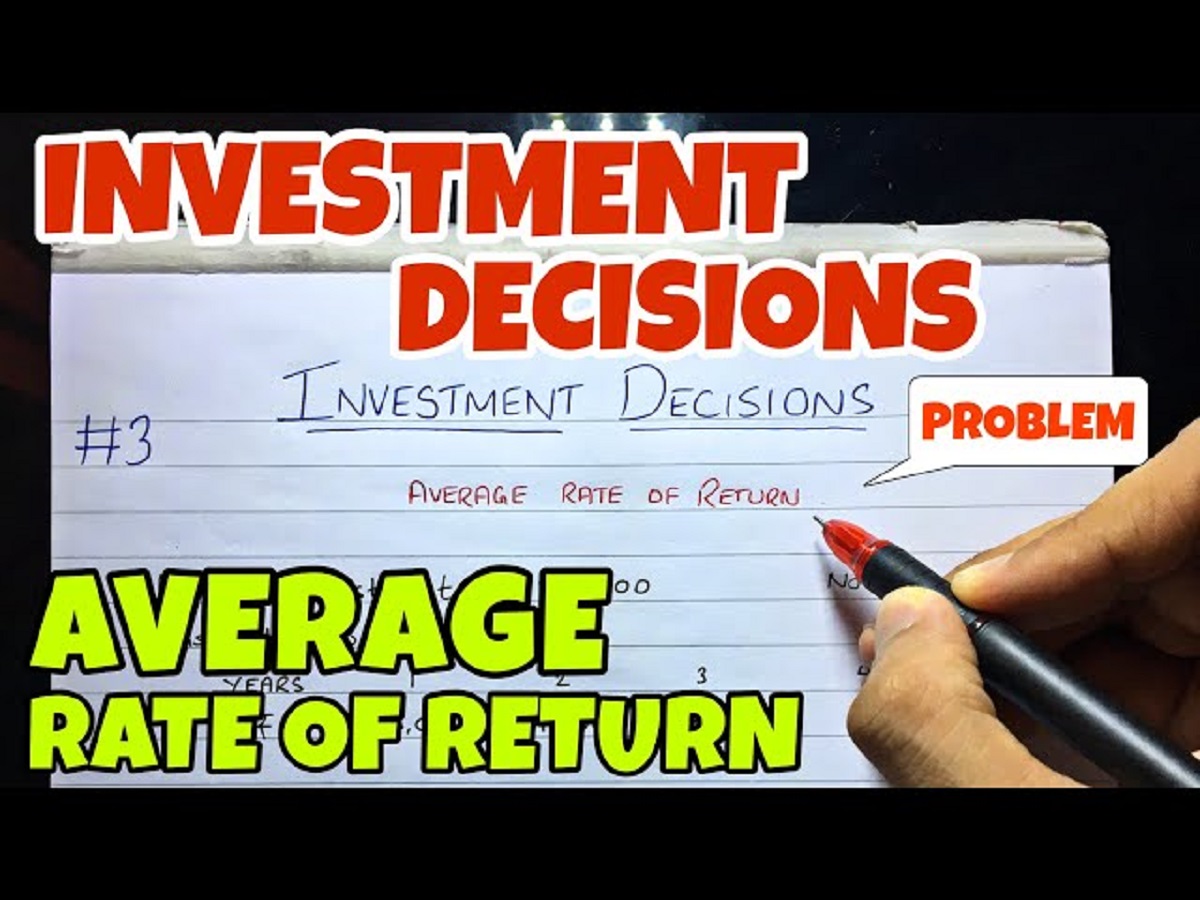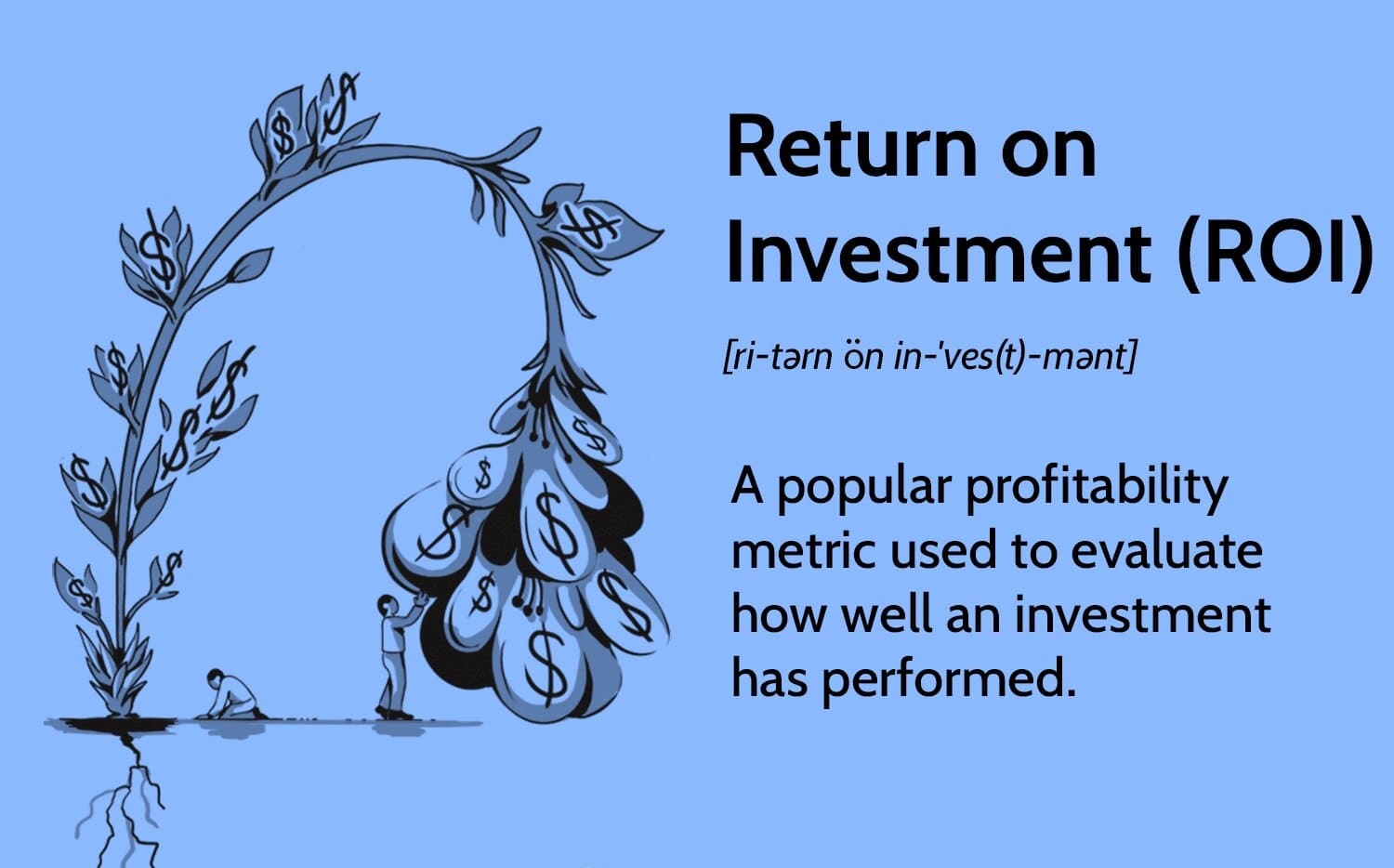Introduction
Investing is a key way to grow and preserve wealth over time. However, understanding how your investments are performing is crucial to making informed financial decisions. One of the most commonly used metrics to evaluate investment performance is the average rate of return.
The average rate of return is a measure that helps investors gauge the profitability of their investments over a specific period. It provides insights into the overall performance of an investment portfolio, enabling investors to assess the success of their strategies and make necessary adjustments.
Having a clear understanding of the average rate of return is essential for both seasoned investors and beginners. It serves as a benchmark for assessing the effectiveness of different investments, helping individuals to make informed choices about where to invest their hard-earned money.
In this article, we will delve into the concept of average rate of return, its calculation, factors that can affect it, and its significance in making investment decisions. Additionally, we will explore the difference between average rate of return and compound annual growth rate (CAGR) and discuss realistic expectations for average rate of return.
By the end of this article, you will have a solid understanding of what the average rate of return entails and how it can guide your investment decisions in the pursuit of financial success.
What is an average rate of return?
The average rate of return is a financial metric used to measure the profitability of an investment or a portfolio over a specific period. It represents the average percentage increase or decrease in the value of an investment per year, taking into account all the gains and losses incurred during that time.
For example, let’s say you invested $10,000 in a stock and after one year, the value of your investment increased to $11,000. In the following year, the value decreased to $9,000. The average rate of return for this two-year period would be calculated by taking into account both the gain and the loss. In this case, the average rate of return would be 0% since the value of the investment remained unchanged over the two-year period.
The average rate of return allows investors to assess the overall performance of their investments, taking into account the ups and downs that occur during the investment period. It provides a more accurate picture of the investment’s performance than simply looking at the ending value without considering the fluctuations along the way.
It’s important to note that the average rate of return is an annualized figure, meaning it is expressed as a percentage per year. This allows for easy comparison between different investments and helps investors evaluate the effectiveness of their portfolio management strategies.
The average rate of return is a useful tool for investors to determine whether their investments are meeting their financial goals and expectations. It helps investors evaluate the success of their investment decisions and make necessary adjustments to their portfolios.
Throughout this article, we will explore the concept of average rate of return in more detail, including how to calculate it, factors that can affect it, and its significance in making informed investment decisions.
The importance of understanding average rate of return
Understanding the average rate of return is crucial for investors as it provides valuable insights into the performance of their investments. Here are a few key reasons why understanding this metric is important:
Evaluating investment performance: The average rate of return allows investors to assess how well their investments are performing over a specific period of time. By comparing the average rate of return against their desired financial goals, investors can determine if they are on track or if adjustments need to be made to their investment strategies.
Comparing different investments: The average rate of return is especially useful for comparing the performance of different investment options. It provides a standardized measure that enables investors to evaluate the relative profitability of various investment opportunities. By considering the average rate of return, investors can make more informed decisions about where to allocate their funds.
Managing risk: Understanding the average rate of return helps investors assess the level of risk associated with their investments. Investments with higher average rates of return may come with higher volatility and increased risk. By analyzing the historical average rate of return, investors can better gauge the potential risks and rewards of their investment choices and make adjustments accordingly.
Long-term planning: The average rate of return is an essential tool for long-term financial planning. It aids investors in projecting the growth of their investments over extended periods and estimating potential future returns. By having a realistic understanding of the expected average rate of return, investors can set more accurate financial goals and create effective investment strategies.
Monitoring investment performance: Regularly tracking the average rate of return allows investors to stay informed about the progress of their investments. By monitoring this metric, investors can identify trends, spot any significant deviations from expected performance, and take appropriate actions to maximize their returns or mitigate potential losses.
Overall, understanding the average rate of return is vital for investors to assess the effectiveness of their investment decisions, evaluate different investment options, manage risk, plan for the future, and monitor the performance of their portfolios. By having a grasp of this important metric, investors can make informed decisions and work towards achieving their financial goals.
How to calculate average rate of return
Calculating the average rate of return is a straightforward process that requires a few key pieces of information. Here is a step-by-step guide to help you calculate the average rate of return for your investments:
- Collect the necessary data: Start by gathering the data needed to calculate the average rate of return. This includes the initial investment amount, the ending value of the investment, and the duration of the investment period.
- Calculate the total return: To calculate the total return of the investment, subtract the initial investment amount from the ending value of the investment. For example, if you initially invested $10,000 and the ending value of the investment is $12,000, the total return would be $2,000.
- Divide the total return by the initial investment: Next, divide the total return by the initial investment amount. Using the previous example, divide $2,000 by $10,000 to get 0.2.
- Multiply by 100 to get a percentage: To convert the decimal value to a percentage, multiply the result obtained in the previous step by 100. In this case, 0.2 multiplied by 100 equals 20%.
- Determine the investment period: It is important to specify the duration of the investment period for which you are calculating the average rate of return. This could be one year, multiple years, or any specific time frame.
- Calculate the average rate of return: To calculate the average rate of return, divide the percentage obtained in step 4 by the investment period. For instance, if the investment period is 5 years, and the percentage obtained in the previous step was 20%, the average rate of return would be 4% (20% divided by 5).
By following these steps, you can calculate the average rate of return for your investments. This metric provides a clear measure of the profitability of your investments over a specific period, allowing you to evaluate their performance and make informed decisions about future investments.
Factors that can affect average rate of return
Several factors can influence the average rate of return for investments. Understanding these factors is essential as they play a significant role in determining the profitability and performance of your investments. Here are some key factors to consider:
Market conditions: The overall state of the financial markets can have a substantial impact on the average rate of return. During bullish market conditions, where stock prices are rising, investments tend to generate higher returns. Conversely, during bearish market conditions, where stock prices are declining, investments may experience lower returns. Monitoring market trends and adjusting investment strategies accordingly can help optimize average rates of return.
Investment type: Different investment types have varying levels of risk and return potential, which can directly affect the average rate of return. For example, stocks generally offer higher returns but come with higher levels of volatility, while bonds may provide more stable returns but with lower potential for growth. The choice of investment type can significantly impact the average rate of return achieved.
Diversification: The level of diversification within an investment portfolio can influence the average rate of return. Diversifying investments across various asset classes, industries, and geographic regions can help mitigate risk by spreading it across different investments. This way, the performance of one investment may offset the underperformance of another, potentially leading to a more favorable average rate of return.
Fees and expenses: Investment fees, such as management fees or transaction costs, can impact the average rate of return. These fees reduce the overall return generated by an investment and, over time, can have a significant impact on the average rate of return. It’s important to consider the impact of fees and expenses when assessing the performance of an investment.
Timing and duration: The timing and duration of an investment can affect the average rate of return. Investments held for longer periods generally have a higher likelihood of generating higher average rates of return. However, the timing of buying and selling investments within the holding period can also impact the overall return. It’s important to carefully consider when and how long an investment is held to optimize the average rate of return.
Economic factors: Economic factors such as inflation rates, interest rates, and GDP growth can influence the average rate of return. Inflation erodes the purchasing power of money, while interest rates affect borrowing costs and investment returns. The overall health of the economy can determine the opportunities and risks associated with investments, thereby impacting the average rate of return.
By considering these factors, investors can gain a better understanding of the drivers behind their average rate of return. Monitoring and adapting to these factors can help optimize investment performance and achieve more favorable average rates of return.
The significance of comparing average rate of return
Comparing the average rate of return is a valuable exercise for investors as it provides meaningful insights into the performance of different investments or investment strategies. Here are several reasons why comparing average rates of return is significant:
Assessing performance: Comparing average rates of return allows investors to assess the performance of different investments or portfolios. It provides a standardized metric that enables a side-by-side comparison of the profitability of various investment options. By analyzing the average rates of return, investors can identify which investments or strategies have performed better over a specific period.
Evaluating risk-reward trade-offs: Comparing average rates of return assists investors in evaluating the risk-reward trade-offs associated with different investments or strategies. Investments that offer higher average rates of return may also come with higher levels of risk and volatility. By comparing average rates of return and analyzing associated risks, investors can make more informed decisions about balancing the potential rewards against the potential risks.
Optimizing portfolio allocation: Comparing average rates of return helps investors optimize the allocation of their investment portfolios. By comparing the performance of various asset classes or investment options, investors can determine which segments are generating higher average rates of return. This information can guide portfolio reallocation decisions to maximize returns and align the portfolio with their investment objectives.
Identifying outperforming investments: Comparing average rates of return can help investors identify investments that have consistently outperformed others over a specific period. By analyzing historical data and comparing average rates of return, investors can identify potential winners and make informed decisions about including or increasing exposure to these investments in their portfolios.
Informing future investment decisions: Comparing average rates of return provides valuable insights for informing future investment decisions. By analyzing the historical performance of investments and comparing their average rates of return, investors can gain a better understanding of which strategies or asset classes may be more likely to generate favorable returns in the future. This information can guide future investment allocations and ultimately improve the overall performance of an investment portfolio.
Overall, comparing average rates of return is a crucial step in evaluating investment performance, assessing risk-reward trade-offs, optimizing portfolio allocation, identifying outperforming investments, and making informed decisions about future investments. By considering the average rates of return, investors can better align their portfolios with their financial goals and work towards achieving long-term investment success.
Average rate of return vs. compound annual growth rate (CAGR)
When evaluating investment performance, two commonly used metrics are the average rate of return and the compound annual growth rate (CAGR). While these metrics are related, they measure different aspects of investment returns. Here are the key differences between the average rate of return and CAGR:
Average rate of return: The average rate of return measures the overall performance of an investment or portfolio over a specific period. It calculates the average percentage increase or decrease in the value of an investment per year, taking into account all gains and losses incurred. The average rate of return provides a useful snapshot of the investment’s profitability, allowing investors to assess its performance.
Compound annual growth rate (CAGR): The compound annual growth rate, on the other hand, measures the annualized growth rate of an investment over a specified period, assuming that the investment compounded at a steady rate. CAGR smooths out the investment’s returns over time, providing a reliable measure of its growth rate. It is calculated as a single rate that, if compounded annually, would lead to the same ending value as the actual investment.
The main difference between the two metrics lies in how they consider the impact of compounding. The average rate of return takes into account all the gains and losses, regardless of how compound interest affects the investment. It provides an average annual return based on the total return over the investment period.
On the other hand, CAGR considers the compounding effect and provides a consistent growth rate across multiple periods. It assumes that the investment’s returns are compounded at a regular rate, which may differ from the actual returns experienced. CAGR allows investors to understand the consistent growth rate required to achieve the ending value of the investment over the specified period.
While the average rate of return provides a broader view of an investment’s performance, CAGR focuses specifically on the growth rate. As a result, CAGR can be particularly useful for comparing the growth rates of different investments or evaluating the potential returns of investment options over a specified period.
Both the average rate of return and CAGR are valuable tools for evaluating investment performance. The average rate of return gives a comprehensive perspective of overall performance, considering all gains and losses. CAGR, on the other hand, provides a consistent growth rate that accounts for the compounding effect. Investors should consider using both metrics to gain a more complete understanding of investment returns and make informed decisions about their portfolios.
Realistic expectations for average rate of return
When it comes to investing, it is important to set realistic expectations for the average rate of return. While every investor aims to maximize their returns, it is crucial to have a clear understanding of what can be reasonably achieved. Here are some factors to consider when setting realistic expectations for average rate of return:
Investment type: The type of investment you choose will significantly impact the average rate of return you can expect. Generally, investments with higher potential returns, such as stocks or real estate, also come with higher levels of risk and volatility. More conservative investments, like bonds or savings accounts, may provide lower returns but with greater stability.
Market conditions: The performance of the overall market plays a significant role in determining average rates of return. During periods of economic growth and favorable market conditions, higher average rates of return may be achievable. Conversely, during economic downturns or bear markets, average rates of return may be lower. It is important to be aware of the current market conditions and adjust expectations accordingly.
Historical performance: Reviewing the historical performance of different asset classes or investment options can help set realistic expectations. While past performance does not guarantee future results, it can provide insights into the average rates of return achieved in the past. It is essential to consider the long-term average rates of return rather than short-term fluctuations.
Risk tolerance: Your individual risk tolerance is a crucial factor in setting realistic expectations for average rates of return. Higher-risk investments may offer the potential for higher returns, but they also come with a greater likelihood of experiencing losses. It is important to align your investment strategy with your risk tolerance to ensure that your expectations are realistic and manageable.
Inflation and taxes: When considering average rates of return, it is important to take into account the impact of inflation and taxes. Inflation erodes the purchasing power of money over time, which means that achieving a positive real rate of return (return above inflation) is important. Additionally, taxes on investment gains can reduce the overall return on your investments. It is important to consider these factors when setting expectations for average rates of return.
Time horizon: The length of your investment time horizon is a critical factor in determining realistic expectations. Investments held for longer periods generally have the potential to generate higher average rates of return. It is important to have a long-term perspective and not get discouraged by short-term fluctuations.
Setting realistic expectations for average rates of return is crucial for successful investing. By considering investment types, market conditions, historical performance, risk tolerance, inflation and taxes, and your time horizon, you can set expectations that align with your financial goals. It is always wise to consult with a financial advisor to tailor your expectations to your specific circumstances and investment objectives.
Conclusion
The average rate of return is a crucial metric for investors to assess the profitability and performance of their investments. By understanding and calculating the average rate of return, investors can gain valuable insights into the effectiveness of their investment strategies, evaluate different investment options, and make informed decisions to achieve their financial goals.
In this article, we explored the concept of average rate of return, its calculation, and factors that can affect it. We also highlighted the importance of comparing average rates of return, as well as the distinction between average rate of return and compound annual growth rate (CAGR). It is important to consider the significance of setting realistic expectations for average rates of return, taking into account investment type, market conditions, historical performance, risk tolerance, inflation, taxes, and time horizon.
By leveraging the average rate of return, investors can monitor and evaluate the performance of their investments, identify outperforming investments, and optimize their portfolio allocations. It is important to remember that investing involves risks, and past performance is not indicative of future results. Seeking guidance from financial advisors and conducting thorough research can provide a solid foundation for making sound investment decisions.
Ultimately, understanding the average rate of return is essential for investors to navigate the complex world of investing and work towards achieving their financial objectives. By keeping realistic expectations and leveraging this key metric, investors can enhance their chances of long-term investment success.

























